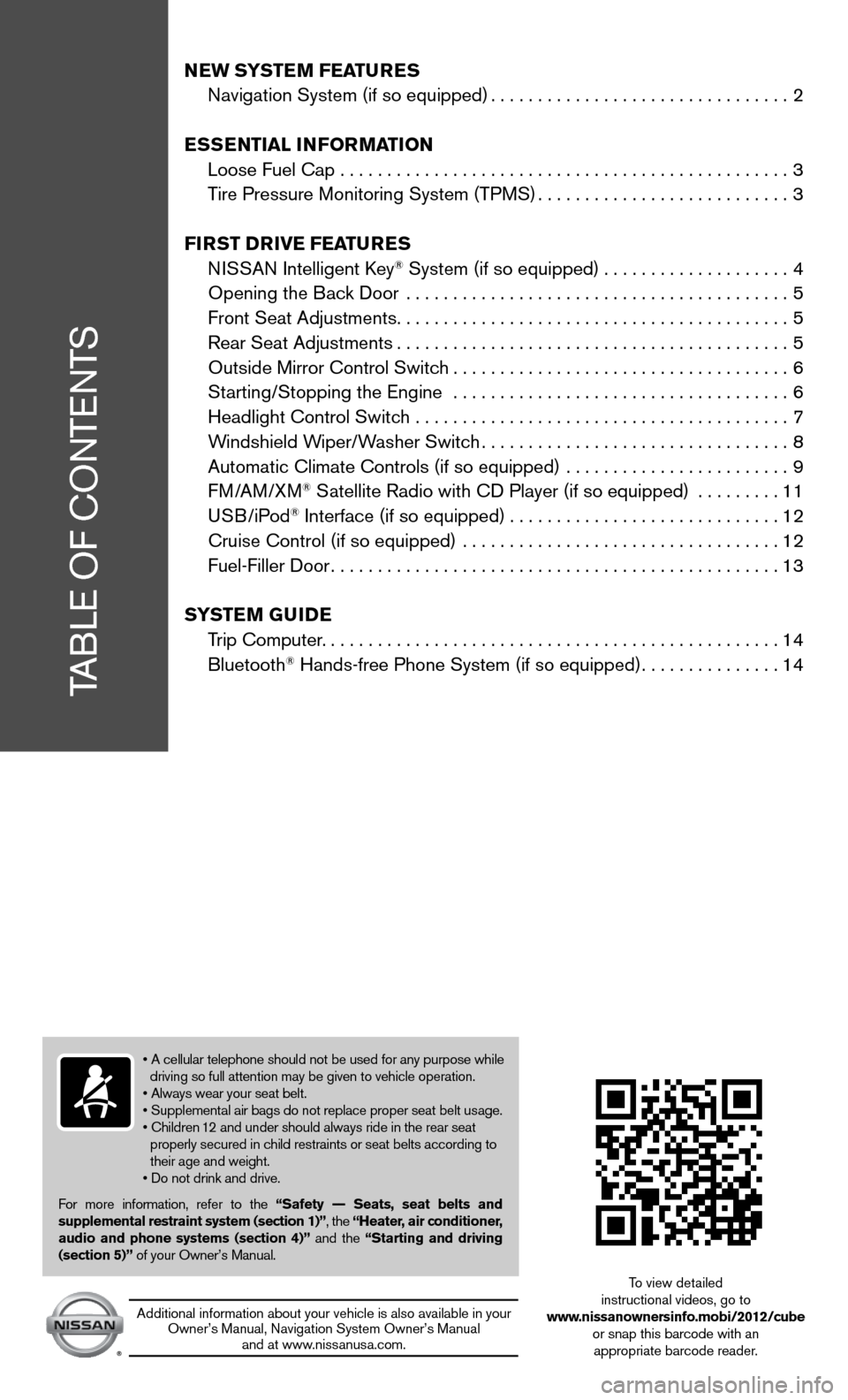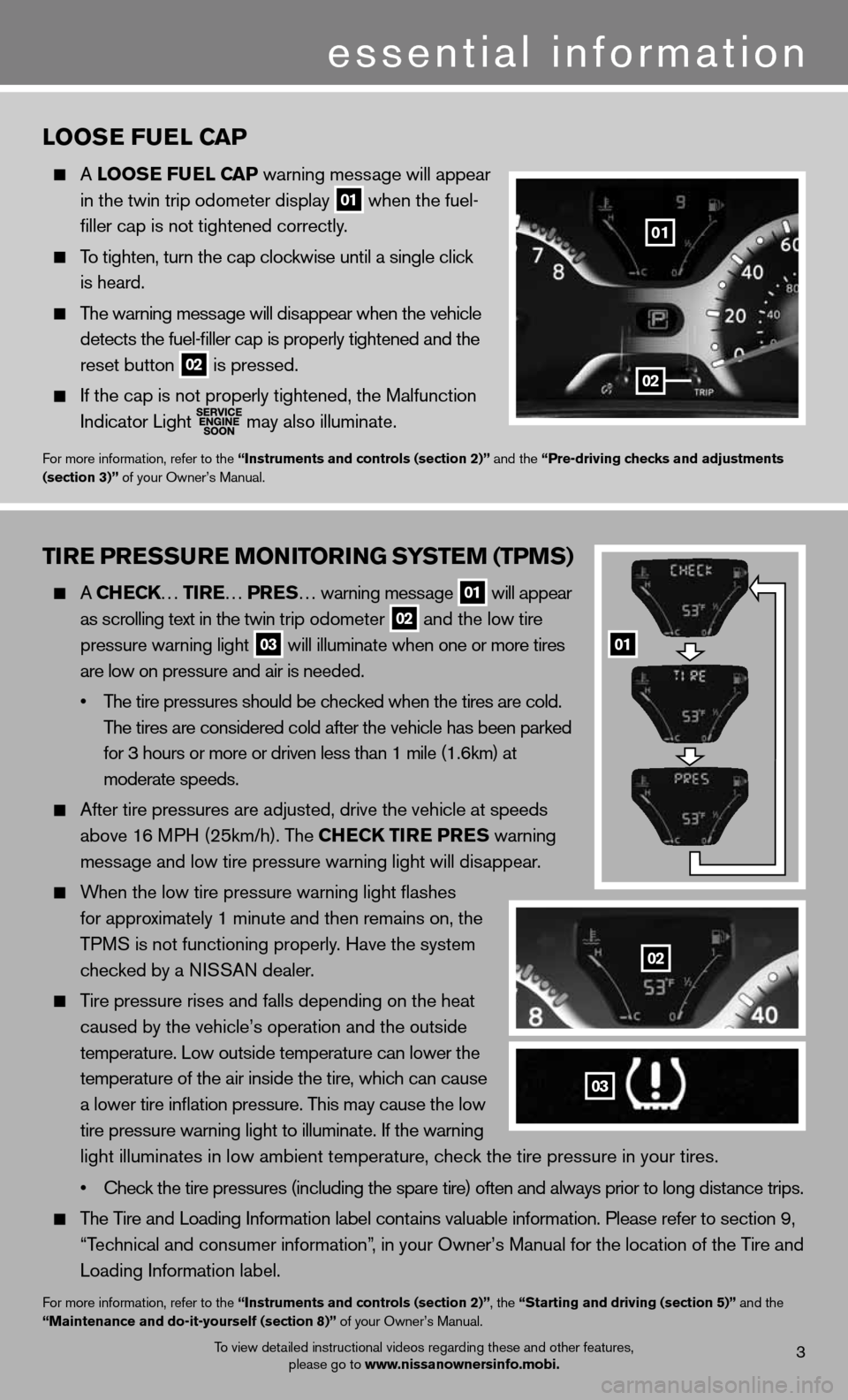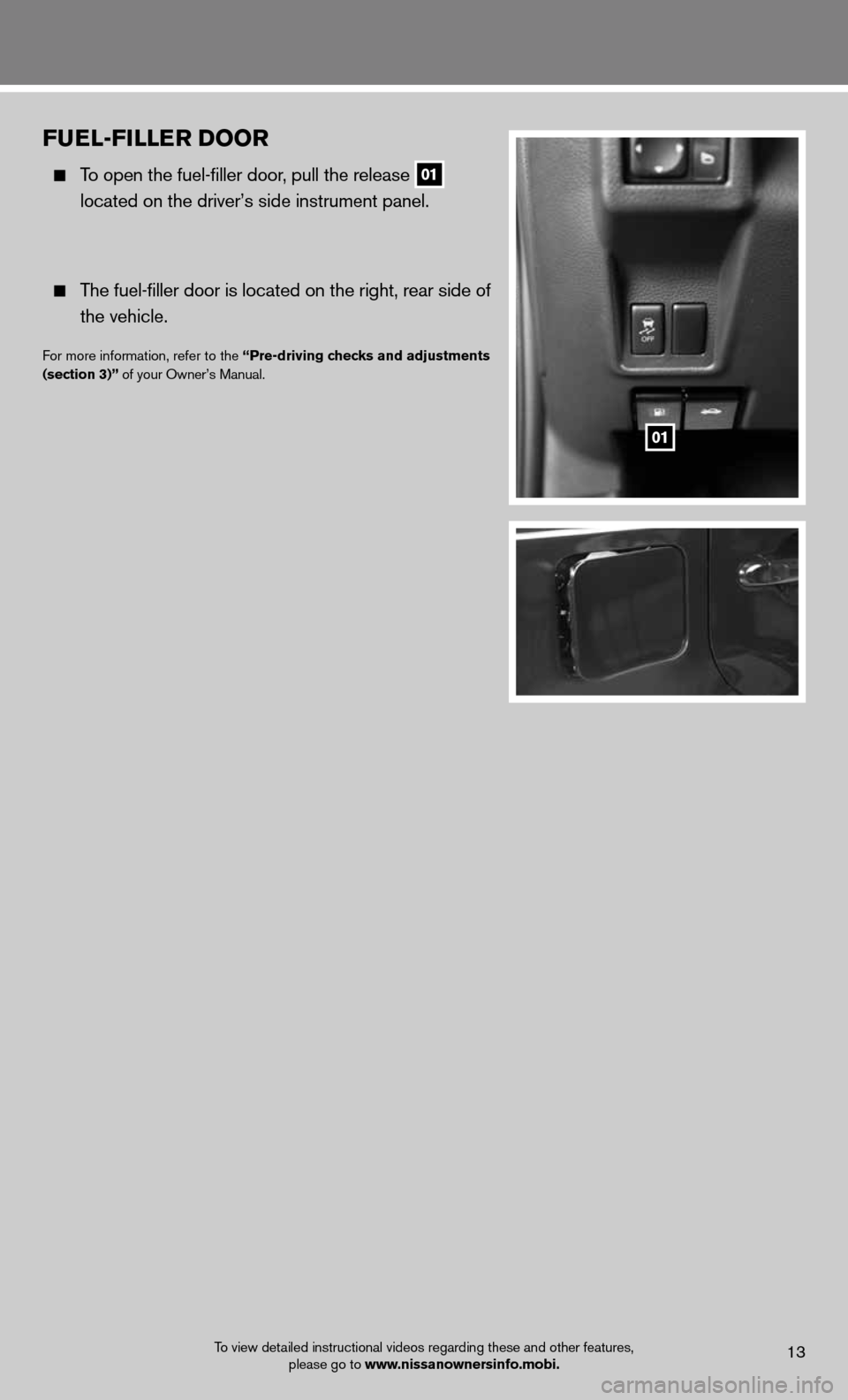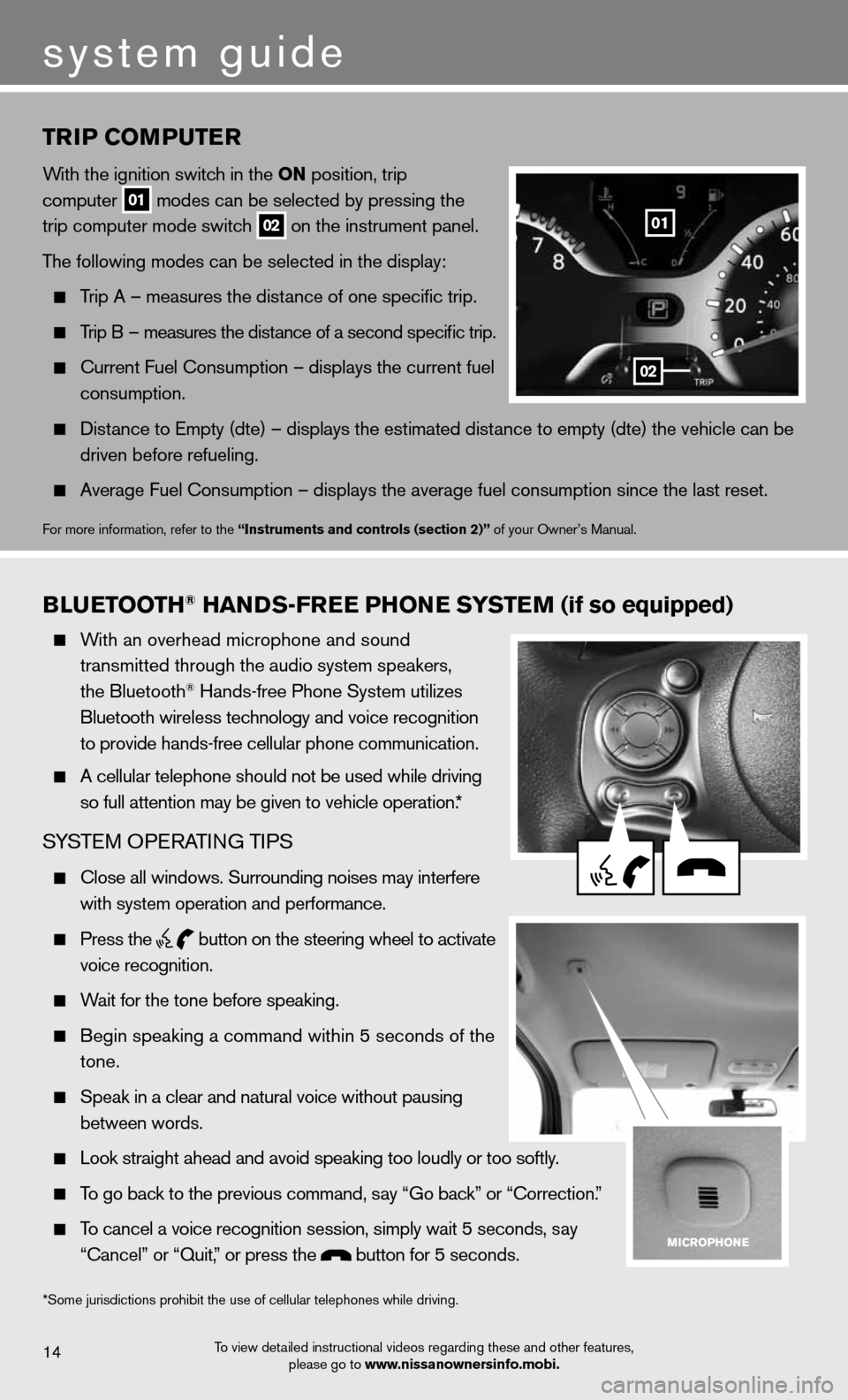2012 NISSAN CUBE fuel
[x] Cancel search: fuelPage 3 of 20

TABLe Of cOnTenTS
New SYSTe M FeaTureS
navigation System (if so equipped) ................................2
e SS eNTIaL INFOr MaTION
Loose fuel cap . . . . . . . . . . . . . . . . . . . . . . . . . . . . . . . . . . . .\
. . . . . . . . . . . . 3
Tire Pressure Monitoring System (TPMS) ...........................3
FI rST D rIVe Fea TureS
ni SSAn intelligent k ey
® System (if so equipped) ....................4
Opening the Back door ......................................... 5
front Seat Adjustments .......................................... 5
Rear Seat Adjustments .......................................... 5
Outside Mirror control Switch .................................... 6
Starting/Stopping the engine .................................... 6
Headlight control Switch ........................................ 7
Windshield Wiper/Washer Switch ................................. 8
Automatic climate controls (if so equipped) ........................ 9
f M/AM/XM
® Satellite Radio with cd Player (if so equipped) ......... 11
u SB/iPod® interface (if so equipped) ............................. 12
cruise control (if so equipped) .................................. 12
fuel-filler door ................................................ 13
SYST eM GuIDe
Trip computer. ................................................ 14
Bluetooth
® Hands-free Phone System (if so equipped) ...............14
• A cellular telephone should not be used for any purpose while
driving so full attention may be given to vehicle operation.
• Always wear your seat belt.
• Supplemental air bags do not replace proper seat belt usage.
• Children 12 and under should always ride in the rear seat
properly secured in child restraints or seat belts according to
their age and weight.
• Do not drink and drive.
f or more information, refer to the “Safety –– Seats, seat belts and
supplemental restraint system (section 1)”, the “Heater, air conditioner,
audio and phone systems (section 4)” and the “Starting and driving
(section 5)” of your Owner’s Manual.
Additional information about your vehicle is also available in your Owner’s Manual, navigation System Owner’s Manual and at www.nissanusa.com.
To view detailed
instructional videos, go to
www.nissanownersinfo.mobi/2012/cube or snap this barcode with an appropriate barcode reader.
Page 5 of 20

LOOSe Fue L CaP
A LOOS e FueL CaP warning message will appear
in the twin trip odometer display
01 when the fuel-
filler cap is not tightened correctly.
To tighten, turn the cap clockwise until a single click
is heard.
The warning message will disappear when the vehicle
detects the fuel-filler cap is properly tightened and the
reset button
02 is pressed.
if the cap is not properly tightened, the Malfunction
indicator Light
may also illuminate.
f
or more information, refer to the “Instruments and controls (section 2)” and the “Pre-driving checks and adjustments
(section 3)” of your Owner’s Manual.
3
essential information
01
02
To view detailed instructional videos regarding these and other features, please go to www.nissanownersinfo.mobi.
TIre Pre SSure MONITOr ING SYSTeM (TPMS)
A CHeCK… TIre… PreS … warning message 01 will appear
as scrolling text in the twin trip odometer 02 and the low tire
pressure warning light
03 will illuminate when one or more tires
are low on pressure and air is needed.
• The tire pressures should be checked when the tires are cold.
The tires are considered cold after the vehicle has been parked
for 3 hours or more or driven less than 1 mile (1.6km) at
moderate speeds.
After tire pressures are adjusted, drive the vehicle at speeds
above 16 MPH (25km/h). The CH eCK TI re Pre S warning
message and low tire pressure warning light will disappear.
When the low tire pressure warning light
flashes
for approximately 1 minute and then remains on, the
TPMS is not functioning properly. Have the system
checked by a ni SSAn dealer.
Tire pressure rises and falls depending on the heat
caused by the vehicle’s operation and the outside
temperature. Low outside temperature can lower the
temperature of the air inside the tire, which can cause
a lower tire inflation pressure. This may cause the low
tire pressure warning light to illuminate. if the warning
light illuminates in low ambient temperature, check the tire pressure in your tires.
• Check the tire pressures (including the spare tire) often and always prior to long distance trips.
The Tire and Loading information label contains valuable information. Please refer to section 9,
“Technical and consumer information”, in your Owner’s Manual for the location of the Tire and
Loading information label.
for more information, refer to the “Instruments and controls (section 2)”, the “Starting and driving (section 5)” and the
“Maintenance and do-it-yourself (section 8)” of your Owner’s Manual.
03
01
02
Page 15 of 20

FueL-FILLer DOOr
To open the fuel-filler door, pull the release
01
located on the driver’s side instrument panel.
The fuel-filler door is located on the right, rear side of
the vehicle.
for more information, refer to the “Pre-driving checks and adjustments
(section 3)” of your Owner’s Manual.
01
To view detailed instructional videos regarding these and other features, please go to www.nissanownersinfo.mobi.13
Page 16 of 20

BLueTOOTH® HaNDS-Free PHONe SYSTeM (if so equipped)
With an overhead microphone and sound
transmitted through the audio system speakers,
the Bluetooth
® Hands-free Phone System utilizes
Bluetooth wireless technology and voice recognition
to provide hands-free cellular phone communication.
A cellular telephone should not be used while driving
so full attention may be given to vehicle operation.*
SYSTe M OPeRATin G TiPS
close all windows. Surrounding noises may interfere
with system operation and performance.
Press the
button on the steering wheel to activate
voice recognition.
Wait for the tone before speaking.
Begin speaking a command within 5 seconds of the
tone.
Speak in a clear and natural voice without pausing
between words.
Look straight ahead and avoid speaking too loudly or too softly.
To go back to the previous command, say “Go back” or “correction.”
To cancel a voice recognition session, simply wait 5 seconds, say
“cancel” or “Quit,” or press the
button for 5 seconds.
TrIP COMPuTer
With the ignition switch in the ON position, trip
computer
01 modes can be selected by pressing the
trip computer mode switch 02 on the instrument panel.
The following modes can be selected in the display:
Trip A – measures the distance of one specific trip.
Trip B – measures the distance of a second specific trip.
current fuel consumption – displays the current fuel
consumption.
distance to empty (dte) – displays the estimated distance to empty (dte) the vehicle can be
driven before refueling.
Average fuel consumption – displays the average fuel consumption since the last res\
et.
for more information, refer to the “Instruments and controls (section 2)” of your Owner’s Manual.
01
02
To view detailed instructional videos regarding these and other features,
please go to www.nissanownersinfo.mobi.14
system guide
*Some jurisdictions prohibit the use of cellular telephones while drivin\
g.